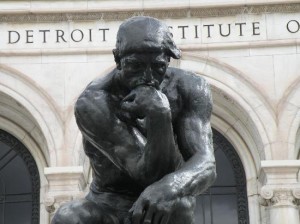Michigan governor Rick Snyder made a statement this afternoon affirming, as predicted this morning, a settlement that would probably rescue the DIA, though some details need to be worked out.
 And it seems that whoever, several weeks back, made the link between saving the museum from selling art and ensuring that pensioners got paid provided the key to the settlement in the legislature. Snyder said — addressing the press in Lansing today (The Detroit News has a video of the occasion, as does the Free Press) that that was a condition, as well as the promise that “the state could not be held liable for future legal claims by retirees.”
And it seems that whoever, several weeks back, made the link between saving the museum from selling art and ensuring that pensioners got paid provided the key to the settlement in the legislature. Snyder said — addressing the press in Lansing today (The Detroit News has a video of the occasion, as does the Free Press) that that was a condition, as well as the promise that “the state could not be held liable for future legal claims by retirees.”
As he has said before, the state would pledge $350 million in state funds over 20 years, essentially matching foundation money, to “protect both city retirees and the priceless collection of the Detroit Institute of Arts,” as the Free Press put it.
The DIA issued a statement, saying:
Governor Snyder’s announcement is continued good news for the City of Detroit, its pensioners and the DIA. Support from the Governor and legislative leadership, the foundation community and our supporters underscores the importance of the DIA in building a strong, healthy city and state. We are working hard to play an active and thoughtful role in this ongoing process that will allow for a significant contribution to this effort and ensure long-term support for the City’s pension funds and sustainability for the DIA. While there has been a great deal of speculation as to the DIA’s participation in this effort, the DIA remains focused on continuing conversations with the mediation team, state, county and city officials, our board members, staff and supporters to determine how we can be as productive and supportive as possible in this process, with the ultimate goal of a balanced, achievable solution that provides for strong DIA involvement in this emerging plan and ensures the museum’s ability to meet its immediate budget commitments and long-term endowment needs.
Earlier in the day, various people had criticized the DIA director Graham Beal and Executive Vice President Annmarie Erickson for saying that the museum could not raise the $100 million that was expected as part of the deal (on top of the $300 million they must raise in 10 years for an endowment to replace the tri-county millage currently providing operating funds).
Much of the state’s contributed funds would come from the tobacco settlement state reached with cigarette manufacturers in 1998.
This is what I hoped would happen last month.
Obstacles definitely remain: Snyder said, as the Free Press put it, that the “state’s contribution would be conditional on “independent fiduciary management†of Detroit pension funds. It also would have to be part of a settlement of the bankruptcy that included the unions and retirees and ended court cases.” Also, bankruptcy judge Steven Rhodes has to approve it.
No surprise, Emergency Manager Kevyn Orr (who was appointed by Snyder) is going along, according to the Free Press:
Detroit Emergency Manager Kevyn Orr said “we now have an unprecedented commitment of public and private resources to help the City of Detroit fulfill its commitments to retirees and preserve one if its cultural jewels, the Detroit Institute of Arts.â€
“The level of proposed investment by the philanthropic community and the state will go far in helping reach a timely and positive resolution of the city’s financial emergency,†Orr said.
Also today, judge Steven Rhodes turned down a request by the city’s creditors for another evaluation of the DIA’s city-owned art; they had complained that the evaluation by Christie’s was too low. And he “raised questions about whether he would even allow the sale of DIA art to settle city debt — while also emphasizing that he had not yet made up his mind on the matter,” the Free Press said.
Bottom line: the conversation re: the DIA has turned the corner, but the museum is not home free. Requiring the DIA to raise $400 million in ten years, plus the money it now raises for operating funds the millage doesn’t cover (in the neighborhood of $7 or 8 million annually if memory serves), could simply kick the museum’s problem down the road.
